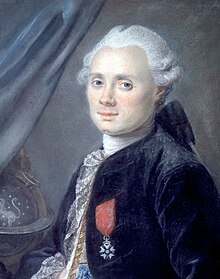Lexell's Comet
| Discovery | |
|---|---|
| Discovered by | Charles Messier |
| Discovery date | June 14, 1770[1] |
| Designations | |
| 1770 I, P/Lexell, Lexell's Comet | |
| Orbital characteristics | |
| Epoch | 1770-Aug-14 (JD 2367764.5) |
| Perihelion | 0.674449 (before Jupiter encounter of 1779) |
| Eccentricity | 0.786119 |
| Inclination | 1.5517° |
| Last perihelion | August 14, 1770 |
| Next perihelion | unknown/Lost |
D/1770 L1, popularly known as Lexell's Comet after its orbit computer Anders Johan Lexell, was a comet discovered by astronomer Charles Messier in June 1770.[note 1] It is notable for having passed closer to Earth than any other comet in recorded history, approaching to a distance of only 0.015 astronomical units (2,200,000 km; 1,400,000 mi).[1][2][3] The comet has not been seen since 1770 and is considered a lost comet.
Discovery

The comet was discovered on June 14, 1770, in the constellation Sagittarius by Messier, who had just completed an observation of Jupiter and was examining several nebulae.[1] At this time it was very faint, but his observations over the course of the next few days showed that it rapidly grew in size, its coma reaching 27 arcminutes across by June 24: by this time it was of magnitude +2. The comet was also noted by several other astronomers.
The comet was observed in Japan. Surviving records identify it as an astronomical and historical phenomenon.[4]
Close approach to Earth
On July 1, 1770, the comet passed 0.015 astronomical units from Earth,[3] or approximately 6 times the radius of the Moon's orbit. Charles Messier measured the coma as 2° 23' across, around four times the apparent angular size of the Moon. An English astronomer at the time noted the comet crossing over 42° of sky in 24 hours; he described the nucleus as being as large as Jupiter, "surrounded with a coma of silver light, the brightest part of which was as large as the moon's orb".[1]
Messier was the last astronomer to observe the comet as it moved away from the Sun, on October 3, 1770.[1]
Orbit
Scientists at the time largely believed that comets originated outside the solar system, and therefore initial attempts to model the comet's orbit assumed a parabolic trajectory, which indicated a perihelion date (the date of the closest approach to the Sun) of August 9–10.[5] When it turned out that the parabolic solution was not a good fit to the comet's orbit, Anders Johan Lexell suggested that the comet followed an elliptical orbit. His calculations, made over a period of several years, gave a perihelion of August 13–14 and an orbital period of 5.58 years.[1] Lexell also noted that, despite this short-period orbit, by far the shortest known at the time, the comet was unlikely to have been seen previously because its orbit had been radically altered in 1767 by the gravitational forces of Jupiter.[6] It is, therefore, the earliest identified Jupiter family comet (as well as the first known Near-Earth Object).[7]
The comet was never seen again. Lexell, after conducting further work in cooperation with Pierre-Simon Laplace, argued that a subsequent interaction with Jupiter in 1779 had further perturbed its orbit, either placing it too far from Earth to be seen or perhaps ejecting it from the Solar System altogether.[8] The comet likely no longer approaches any closer to the Sun than Jupiter's orbit.[7]
Although Comet Lexell was never seen again, it remained interesting to astronomers. The Paris Academy of Sciences offered a prize for an investigation into the orbit of the comet. Johann Karl Burckhardt won in 1801, and confirmed the calculations of Lexell. He calculated that the 1779 close approach to Jupiter drastically altered its orbit and left it with a perihelion of 3.3 au.[citation needed] In the 1840s, Urbain Le Verrier carried out further work on the comet's orbit and demonstrated that despite potentially approaching Jupiter as close as three and a half radii from the planet's centre the comet could never have become a satellite of Jupiter.[8] He showed that after the second encounter with Jupiter many different trajectories were possible, given the uncertainties of the observations, and the comet could even have been ejected from the Solar System. This foreshadowed the modern scientific idea of chaos.
Lexell's work on the orbit of the comet is considered to be the beginning of modern understanding of orbit determination.[9]
Notes
- Footnotes
- ^ Other comets named after their orbit computer, rather than discoverer, are 27P/Crommelin, 2P/Encke and 1P/Halley - Halley's Comet.
- Citations
- ^ a b c d e f Kronk, G. Cometography: D/1770 L1 (Lexell), accessed November 20, 2008.
- ^ Kronk, G. The Closest Approaches of Comets to Earth, accessed 20 November 20, 2008. It was thought that C/1491 B1 may have approached even closer on February 20, 1491, but its orbit was retracted in 2002 due to a misunderstanding of the records.
- ^ a b Closest Approaches to the Earth by Comets
- ^ Hall, John. (1955). Tanuma Okitsugu, 1719-1788, p. 120.
- ^ Tofigh Heidarzadeh (2008). A History of Physical Theories of Comets, From Aristotle to Whipple. Springer Science & Business Media. p. 196-197. ISBN 1402083238.
- ^ Leverington, D. Babylon to Voyager and Beyond: A History of Planetary Astronomy, Cambridge University Press, 2003, p.193
- ^ a b Valsecchi, G. 'A comet heading towards Earth: the first NEO', in Tumbling Stone, Issue 2, accessed November 21, 2008
- ^ a b Valsecchi, G. 'Le Verrier's computations and the concept of Chaos', in Tumbling Stone, Issue 3, accessed February 11, 2011
- ^ Valsecchi, G. '236 Years Ago...' in Near Earth Objects, Our Celestial Neighbors: Opportunity and Risk : Proceedings of the 236th Symposium of the International Astronomical Union, Cambridge University Press, 2006, xvii-xviii
References
- Hall, John Whitney. (1955). Tanuma Okitsugu, 1719-1788: Forerunner of Modern Japan. Cambridge: Harvard University Press. OCLC 445621


